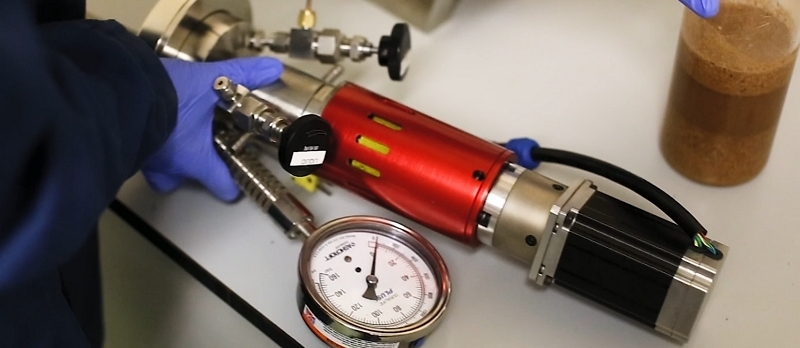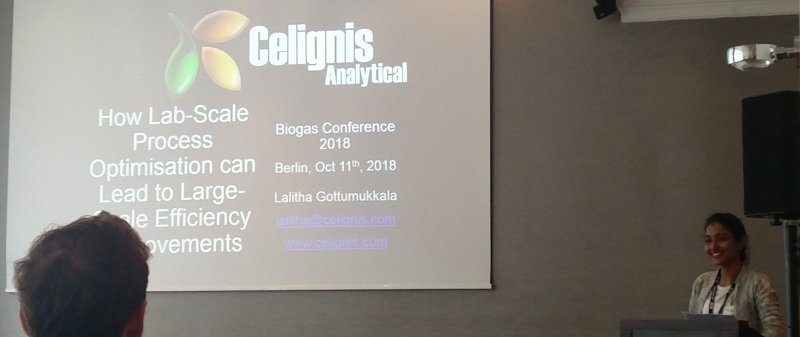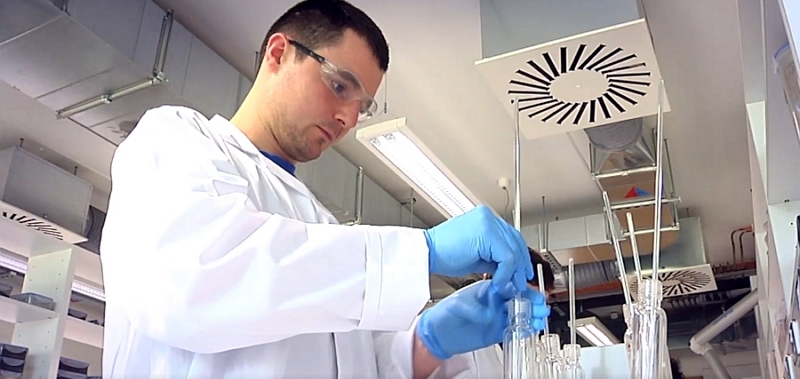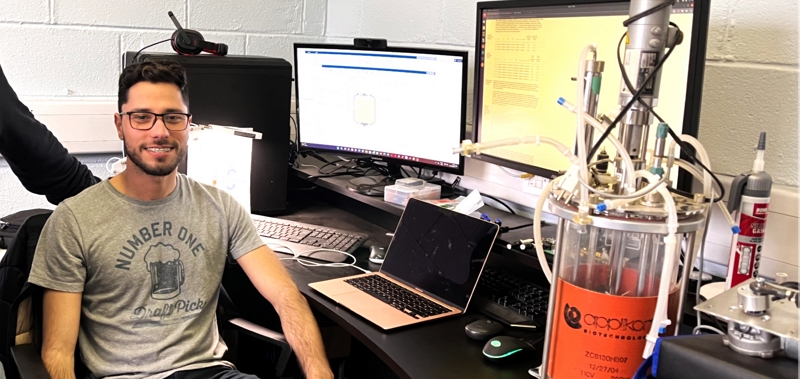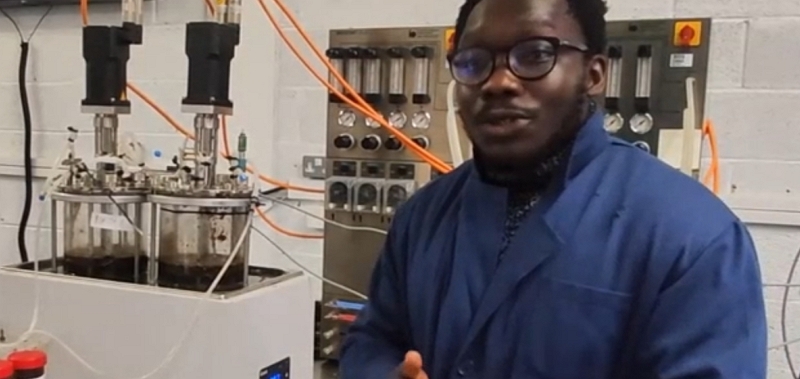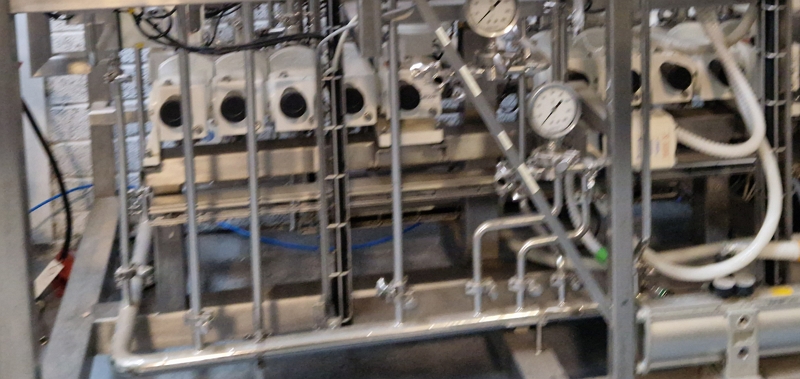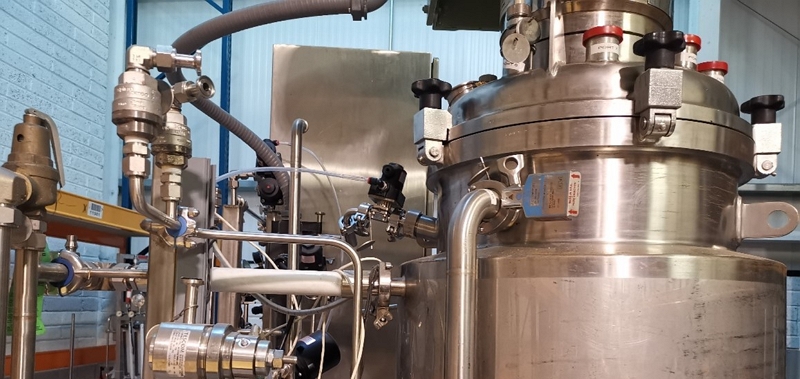Dilute-Acid Hydrolysis of Lignocellulosic Biomass
Lignocellulose Hydrolysis
Lignocellulosic biomass, primarily comprised of cellulose, hemicellulose, and lignin, is an abundant and renewable resource that holds great promise as a source of biofuels and renewable biobased chemicals and biomaterials. Lignocellulosic biomass can be processed in a number of ways, one is through the hydrolysis of the structural polysaccharides (cellulose and hemicellulose) into their constituent sugars, a reaction commonly facilitated by acid or enzymes, followed by the fermentation of these sugars by yeast or other microorganisms.Click below to read more about the hydrolysis of lignocellulosic biomass.
Get more info...Biomass Hydrolysis
Acid Hydrolysis
Hydrolysis of lignocellulose can be catalysed with acids. These can be used in either dilute or concentrated forms, with each approach having its own advantages and disadvantages.Different process intensities are required for the hydrolysis of cellulose versus hemicellulose. The more intense conditions required for cellulose hydrolysis may degrade the sugars hydrolysed from hemicellulose (to products such as furfural and formic acid)
Dilute-Acid Hydrolysis
Dilute-Acid Process
Dilute-acid hydrolysis involves the use of acids, in relatively low concentrations, to catalyse the hydrolysis of lignocellulosic biomass. The approach is often used as a pretreatment to hydrolyse hemicellulose, leaving the cellulose and much of the lignin in the solid which can then be subjected to further hydrolysis. This subsequent hydrolysis can be using enzymes or it can again use dilute-acid, but under more severe process conditions. Click here to read more about the use of dilute-acid in biomass pretreatment. The rest of this page focuses on the use of dilute acids for the more extensive hydrolysis of biomass, including cellulose.Sugar Degradation Products
It can be possible for the production of the monosaccharide to not be the end-point of the dilute-acid process. Some sugars may be further degraded to a variety of different products. For example, furfural can result from the acid-catalysed degradation of pentose (5-carbon) sugars (such as xylose) hydrolysed from hemicellulose. Hydroxymethylfurfural and, with further degradation, levulinic acid and acetic acid, can result from the acid-catalysed degradation of hexose (6-carbon) sugars, such as cellulose-derived glucose.The array of potential sugar degradation products is diverse and complex, and they can also polymerise to give solid residues, often referred to as humins. Additionally, if proteins are present in the feedstock then these can favour the formation of sugars degradation products due to their reactions with carbohydrates under acidic conditions and/or high temperature conditions, under a mechanism known as the Maillard reaction.
The formation of sugar-degradation products is important since they can often be inhibitory to fermentation or can otherwise complicate subsequent downstream processing methods. Click below to read more about the different types of sugar-dergadation products and their analysis.
Get more info...Sugars Degradation Products
Effect of Process Conditions
The efficiency and output of dilute acid hydrolysis are heavily influenced by several key process variables, detailed below:- Acid Type - Different types of acids can be used for the hydrolysis process. The most commonly used are sulphuric acid (H2SO4) and hydrochloric acid (HCl), but others like nitric acid (HNO3) and phosphoric acid (H3PO4) can also be employed. The acid type affects the efficiency of hydrolysis, sugar degradation, and the generation of inhibitory by-products. Sulphuric acid is often preferred due to its strong acidity and relatively low volatility. However, sulphuric acid can lead to the formation of sulfate ions that can potentially interfere with subsequent fermentation.
- Acid Concentration - Acid concentration is one of the most critical factors influencing the hydrolysis rate. Typically, a higher acid concentration accelerates hydrolysis, leading to more rapid breakdown of cellulose and/or hemicellulose, and consequently higher sugar yields. However, excessive acid concentrations can lead to the degradation of sugars into undesirable and inhibitory by-products like furfural and hdroxymethylfurfural (HMF). Additionally, higher acid concentrations increase the corrosiveness of the solution, necessitating more robust and expensive materials for the reactor and associated equipment.
- Temperature - The reaction temperature is another crucial variable in the process. Higher temperatures accelerate the hydrolysis reaction, increasing the rate of sugar release. However, as with acid concentration, an overly high temperature can cause sugar degradation and the production of inhibitory by-products. It can also increase the risk of equipment failure due to the added thermal stress.
- Reaction Time - Reaction time is directly tied to the degree of hydrolysis. Longer reaction times generally increase the yield of monomeric sugars as more cellulose and/or hemicellulose are broken down. However, prolonged exposure to acidic conditions can also increase the degradation of sugars into inhibitory by-products. Thus, it is essential to optimise the reaction time to maximize sugar yield and minimize by-product formation.
Hemicellulose vs. Cellulose
Given that the hydrolysis of hemicellulose requires much less severe process conditions than the hydrolysis of cellulose, and also given that the sugars liberated from hemicellulose are highly susceptible to further conversion to an array of different sugar degradation products, dilute-acid hydrolysis technologies focused on the use of dilute-acid to hydrolyse both polysaccharides tend to involve two stages.The first stage focuses on the dilute-acid catalysed hydrolysis of hemicellulose. This can also be considered to be a dilute-acid pretreatment of the feedstock. This stage involves moderate conditions (e.g. a temperature of 140-180oC).
In the second stage the temperatures are raised (typically to around 200–240oC) to facilitate the hydrolysis of cellulose and recovery of six carbon sugars.
Processing Beyond Sugars
It can be difficult to stop dilute-acid hydrolysis at the production of monomeric sugars. Additionally, sometimes the resulting hydrolysate can be challenging for subsequent fermentation due to the presence of fermentation inhibitors arising from the degradation of these sugars.An alternative objective for dilute-acid hydrolysis technologies can be the targeted production of selected sugar degradation products in high yields. Certain such products (e.g furfural from xylose, HMF and levulinic acid from hexoses) are valuable platform chemicals which can have higher market values than some products of sugar fermentation (e.g. bioethanol). Additionally, following this route would allow for an entirely chemical process that does not require any biological processing. However, there are challenges associated with this approach. For example, careful process control is required to ensure that the desired chemicals are obtained in high yields and that they do not further degrade into undesirable compounds such as humins.
Celignis personnel have prior experience in the optimisation of process conditions targeting furfural and levulinic acid as a result of their participation in an EU-funded collaborative research project (DIBANET) on their production from European and Latin American feedstocks.
Advantages
- Effectiveness - One of the primary benefits of dilute acid hydrolysis is its effectiveness, particularly in hemicellulose degradation. Acid hydrolysis breaks down the hemicellulose component of biomass into monomeric sugars very efficiently, and these can then be further processed into biofuels or other value-added products.
- Speed - Acid hydrolysis is a relatively quick process, often taking only a few minutes to a few hours, depending on the process conditions and the nature of the biomass. This rapid conversion is a significant advantage over enzymatic hydrolysis, which can take days to achieve comparable conversion levels.
- Simplicity and Cost - Dilute acid hydrolysis is a relatively straightforward process, requiring less specialized equipment than some other hydrolysis methods. The acids used (commonly sulphuric acid) are inexpensive and readily available.
- Flexibility - The process is flexible and can be adapted to various types of lignocellulosic biomass, including agricultural residues, hardwoods, softwoods, and herbaceous plants.
- Scalability - Dilute acid hydrolysis is readily scalable. It has been successfully implemented at industrial scales, which is not the case for many alternative hydrolysis methods.
- Pre-treatment Effects - The use of dilute acid not only hydrolyzes hemicellulose but also acts as a pretreatment by disrupting the lignin structure. This pretreatment can enhance the subsequent hydrolysis of cellulose, whether it is done using acid or enzymes.
- Opportunity for Different Products - Where the dilute-acid process targets the further degradation of the liberated sugars, it can allow for the production of a range of different final products (e.g. furfural and levulinic acid) not possible via other routes.
- Non-Biological Process - The process avoids the use of biological steps and can allow for a fully non-biological bioprocess where the final products are not used for subsequent fermentation.
Disadvantages
- Byproduct Formation - During dilute-acid hydrolysis, the released sugars can degrade into inhibitory compounds like furfural and hydroxymethylfurfural (HMF) under the acidic conditions. These compounds can inhibit the subsequent fermentation process, thus reducing the yield of the desired products. Also, the acids can cause the release of lignin and other phenolic compounds that are inhibitory to both hydrolytic enzymes and fermenting microorganisms.
- Incomplete Cellulose Hydrolysis - While dilute-acid hydrolysis effectively degrades hemicellulose, it is often less effective at hydrolysing cellulose. Achieving a high level of cellulose hydrolysis may require more severe conditions, which could lead to an increase in sugar degradation and the formation of inhibitory compounds.
- Corrosiveness - The use of acids, even in dilute form, adds a significant challenge in terms of equipment corrosion. Acid-resistant materials are needed for the reactors and other process equipment, increasing the capital and maintenance costs.
- Environmental Concerns - The acid used in the process and the produced wastewater are environmental concerns. The acid needs to be neutralized after the hydrolysis, and the wastewater may require significant treatment before disposal due to its acidity and the presence of organic compounds.
- Energy Consumption - The process typically requires high temperatures and pressures, leading to higher energy consumption than lower-severity processes such as enzymatic hydrolysis.
- Sugar Recovery - The process can be complicated by difficulties in sugar recovery due to the production of soluble oligosaccharides that may not be readily fermentable. Additionally, the sugars are in a dilute solution after hydrolysis, which can complicate their recovery and increase the costs of downstream processing.
1. Understanding Your Requirements
Prior to undertaking bioprocess projects we learn from our clients what their targets are from the process as well as whether there are any restrictions or requirements that may need to form the boundaries of the work that we undertake. These help to guide us to then prepare a potential bioprocess development project.
2. Detailed Feedstock Analysis
In cases where you have already selected a feedstock for the bioprocess, we would then undertake a detailed compositional analysis (P10 or, ideally, P19) of representative samples of that feedstock.
In cases where the feedstock has not yet been selected we can review your list of candidate feedstocks, selecting top candidates based on our prior experience in their analysis and bioprocessing. If you do not have a list of candidate feedstocks then we can provide one, based on your location and the requirements outlined in Stage 1. We would then analyse in detail these priority feedstocks and come to a decision, based on the compositional data and other relevant factors (e.g. price, supply, consistency etc.) on a selected feedstock for the project.
At this point of the project, the Celignis Bioprocess team typically meet to discuss and prepare a project proposal for the development of a dilute-acid hydrolysis bioprocess from this feedstock. After this proposal is reviewed by the client, and revised if needed, we are then ready to start work on the next stages.
3. Hemicellulose Hydrolysis
Given the different process severities required for hemicellulose and cellulose hydrolysis, it is likely that the first stage of the process will be focused on optimising conditions for the hydrolysis of hemicellulose. Hence, this stage of the project will involve undertaking a number of dilute-acid hydrolysis experiments, covering a variety of process conditions, targeting the desired products of hemicellulose hydrolysis (whether they be monomers or their subsequent degradation products, e.g. furfural). We follow a scientifically-based Design of Experiments (DoE) protocol where the criteria and boundaries for this DoE are formulated in close collaboration with our clients, considering the chemistry of the feedstock(s) and our understandings of the mechanisms of biomass hydrolysis.
For each experiment we analyse the solid and liquid outputs of the process, leading to a detailed data-set where effects of process conditions on the yield and composition of the various streams can be explored and mapped. We usually recommend that these initial optimisation experiments are undertaken at the lab-scale (around TRL3) in order to reduce costs and the length of the project.
We can also undertake a second iteration of lab-scale experiments in order to fine-tune the conditions based on the knowledge gained in the initial experiments.
For this step in the bioprocess it may also be necessary, depending on the composition of the feedstock, to undertake a prior step where the extractives are removed. This is because extractives may negatively interfere with the mechanisms of acid-catalysed hydrolysis of hemicellulose, leading to lower yields of the targeted products and the formation of more unwanted byproducts. Click here to read more about bioprocess development for the removal of extractives from biomass.
4. Cellulose Hydrolysis
This stage of the bioprocess will be focused on the dilute-acid catalysed hydrolysis of the solid residue obtained from Stage 3. As in that stage, this work will involve evaluating the effects of varying a number of different process conditions (e.g. solid-loading, acid-type, acid concentration, temperature, reaction times, mixing) via a detailed DoE being undertaken. This work will allow these conditions to be narrowed down in order that the objectives of the hydrolysis, outlined in Stage 1, can be met.
It is likely that the solid residue being processed in this Stage will mostly be composed of cellulose and the parts of lignin that were not released into the liquid phase in Stage 2. There may also be small amounts of residual unhydrolysed hemicellulose in the solid residue. The targets of the hydrolysis of this residue can either be the effective hydrolysis of cellulose to glucose, or the further acid-catalysed degradation of this sugar to products such as HMF, levulinic acid, and formic acid. If glucose, as a substrate for subsequent fermentation, is the target then a major objective of this Stage would also be a minimisation of the production of compounds that could inhibit this fermentation.
As with Stage 3, it is recommended that the optimisation experiments in Stage 4 are undertaken at the lab-scale in order to accelerate the outputs and reduce project costs.
This stage usually follows Stage 3, however it is possible that there can be some overlap in order to reach the final project outputs more quickly.
5. Downstream Processing
Depending on the outputs of the prior stages, there may need be further downstream steps required in order to achieve the final products. For example, if the final targeted product from cellulose is bioethanol, then this Stage of the bioprocess development can look at utilising the dilute-acid hydrolysate from Stage 4 as a substrate for fermentation. It may be found, based on the analytical data obtained in Stage 4, that the hydrolysate needs to be further-treated (e.g. acids neutralised and fermentation inhibitors removed) before the main fermentation step. Hence, our work in this Stage would focus on optimising the hydrolysate for fermentation and also on optimising the fermentation process itself. Once again, this work would involve a carefully formulated DoE with the experiments undertaken at the lab-scale level.
This Stage can also examine routes for valorising the liquid output stream from Stage 3 (i.e. the hydrolysate from the dilute-acid hydrolysis of hemicellulose).
It is possible for this Stage to run alongside Stage 4.
6. Product Recovery
Based on the outputs of the prior lab-scale Stages we can optimise the methods employed for separating and purifying the target products from the liquid phases.
It is possible for this Stage to run alongside Stage 5.
7. Valorisation of Remaining Biomass
Where dilute-acid hydrolysis is employed for both the hydrolysis of cellulose and hemicellulose, the remaining solid biomass after the cellulose-hydrolysis step (Stage 4) is likely to contain much of the lignin as well as unhydrolysed cellulose and any humin products that may have been formed along the way.
We can undertake a number of different analyses and experiments to determine the best route for valorising this residue. For example, we can evaluate its suitability for combustion.
8. Validation at Higher TRLs
Once we have concluded our optimisation of the dilute-acid hydrolysis process conditions at the lab-scale we can then test those conditions at higher technology readiness levels (TRLs). The scales at which we can operate are dependent on the type of technology employed, but can reach up to 100 litres.
We have all of the necessary downstream equipment to efficiently handle the solid and liquid streams arising from these scaled-up activities.
If we find that there are differences between the yield and compositions of the different streams, compared with our lab-scale experiments, then we can explore the potential reasons for these and work on final tweaks to optimise the bioprocess for higher TRLs.
9. Technoeconomic Analysis (TEA)
The Celignis team, including Oscar our chief TEA expert, can undertake a detailed technoeconomic analysis of the developed process. We apply accurate and realistic costing models to determine the CAPEX and OPEX of simulated and pilot scale processes which are then used to determine key economic indicators such as IRR, NPV and payback periods.
Within these TEAs we can undertake sensitivity analyses to assess the effect of variable costs and revenues on the commercial viability of the process.
Our preferred approach is to include TEA studies at each stage of the development of the bioprocess, so that the process can be optimised in a commercially-relevant way, followed by a more detailed TEA after the process has been optimised and tested at higher TRL levels.
Click here to read more about the technoeconomic analysis (TEA) services offered by Celignis.

Lalitha Gottumukkala
Founder of Celignis Bioprocess, CIO of Celignis
PhD
<p style="text-align: left;">Has a deep understanding of all biological and chemical aspects of bioproceses. Has developed Celignis into a renowned provider of bioprocess development services to a global network of clients.</p>

Oscar Bedzo
Bioprocess Project Manager & Technoeconomic Analysis Lead
PhD
<p style="text-align: left;">A dynamic, purpose-driven chemical engineer with expertise in bioprocess development, process design, simulation and techno-economic analysis over several years in the bioeconomy sector.</p>

Dan Hayes
Celignis CEO And Founder
PhD (Analytical Chemistry)
<p style="text-align: left;">Dreamer and achiever. Took Celignis from a concept in a research project to being the bioeconomy's premier provider of analytical and bioprocessing expertise.</p>


